Last Updated on August 13, 2025
Your bathroom sink’s low water pressure often stems from clogged aerators, leaks in supply lines, or partially closed shut-off valves. Mineral deposits from hard water can narrow pipes or block faucet cartridges, further reducing flow.
Check for corrosion or kinks in supply tubes and make sure valves fully open to restore pressure. If issues persist or affect multiple fixtures, it may indicate a larger plumbing or pressure regulation problem.
Explore these causes to pinpoint and resolve the issue efficiently.
Key Takeaways
- Hidden leaks behind walls or under the sink reduce flow and pressure and may cause water damage if not detected early.
- Clogged or mineral-scaled faucet aerators restrict water flow and require regular cleaning or replacement.
- Partially closed or corroded shut-off valves and supply lines limit water pressure to the sink.
- Aging or corroded pipes and fittings can cause ongoing pressure drops needing professional assessment.
- External factors like municipal supply pressure, elevation, or high home water pressure regulators impact sink water pressure.
Identifying Plumbing Leaks Affecting Sink Pressure
When you notice reduced water pressure at your bathroom sink, the issue often stems from plumbing leaks in the pipes or supply lines feeding the fixture. These leaks allow water to escape through cracks, lowering flow and pressure.
Pumps like inline pumps can be affected by pressure drops caused by leaks in the system. Hidden leaks may appear behind walls, beneath floors, or under the sink, making detection difficult. Look for puddles, damp spots, peeling wallpaper, or warped floorboards as indicators.
A professional plumbing inspection can accurately diagnose these issues using specialized equipment to measure home water pressure. Hidden leaks often hide behind walls or floors; watch for damp spots and warped surfaces as signs.
Excessive water pressure, typically above 80 psi, can cause pinhole leaks that worsen over time. Check for unexplained high water bills or weak flow at other fixtures to identify systemic leaks.
Inspect plumbing connections beneath the sink, as compression fittings and supply line joints are common leak points. Early leak detection prevents further pressure loss and costly water damage.
Cleaning and Maintaining Faucet Aerators
Although faucet aerators are small components, they play an essential role in maintaining steady water pressure and filtering debris in your bathroom sink.
To keep water flowing smoothly, clean aerators at least twice a year or more after plumbing work. Remove the aerator carefully, soak it in white vinegar for 5 minutes to dissolve mineral deposits, scrub with a toothbrush, rinse, and reinstall.
Proper maintenance of these components helps ensure consistent fluid velocity and pressure levels in your plumbing system. Replace aerators if damaged or heavily clogged.
Aerators also limit water waste by adding air to the water flow, which helps reduce splash and conserve water.
Inspecting and Replacing Faucet Cartridges
After cleaning or replacing faucet aerators, you might still notice issues with water flow or pressure. Inspecting and replacing the faucet cartridge can solve these problems.
Regular maintenance extends the cartridge’s lifespan and helps prevent common issues like leaks and inconsistent pressure due to mineral buildup.
- First, shut off the water supply valves and open the faucet to release residual pressure. Proper maintenance and inspections are necessary for optimal faucet performance.
- Remove decorative caps and unscrew the handle to expose the cartridge.
- Use pliers or a wrench to loosen the retaining nut, then carefully pull out the cartridge, noting its orientation.
- Apply silicone grease to the new cartridge’s O-rings before inserting it in the same position.
- Tighten the retaining nut snugly without over-tightening.
- Reattach the handle and decorative parts.
- Turn the water back on slowly to check for leaks and test flow.
If problems persist, verify cartridge alignment or consider further inspection.
Checking Shut-Off Valves and Supply Lines
Since shut-off valves and supply lines directly control the water flow to your bathroom sink, they play a crucial role in maintaining proper water pressure.
Start by ensuring both hot and cold shut-off valves under the sink are fully open; partial closure drastically reduces flow. Understanding how fluid moves can help diagnose pressure issues and is similar to how a submersible pump operates.
Inspect valves for corrosion, mineral buildup, or debris that can clog and restrict water. Check supply lines for kinks, damage, or clogging—older galvanized steel lines are especially prone to rust and scale.
Look for leaks around valves and connections; even small leaks lower pressure and cause water loss. Early leak inspection can prevent more extensive damage and pressure loss.
To isolate the problem, turn off valves, disconnect supply lines, and test flow directly from the valve. If flow is weak, flush valves or consider replacement. Replacing old supply lines with flexible braided lines often restores ideal pressure.
Evaluating Household Water Pressure Issues
Once you’ve confirmed that shut-off valves and supply lines are functioning properly, the next step is to evaluate your household water pressure as a whole.
Start by measuring pressure with a gauge attached to an outdoor spigot; ideal readings range between 40–60 psi. Regularly checking pressure helps maintain system efficiency and prevent costly repairs.
If pressure readings are outside this range, adjusting the water pressure regulator can help restore optimal flow. Begin troubleshooting by confirming shut-off valves and supply lines work, then measure water pressure at an outdoor spigot.
If a gauge isn’t available, estimate flow rate by timing how fast a 1-litre jug fills from the bathroom tap—less than 10 litres per minute indicates low pressure.
Consider these factors:
- Check municipal supply status for system-wide pressure issues.
- Inspect pressure regulators for malfunction or misadjustment.
- Look for hidden leaks diverting water flow.
- Remember peak usage times can temporarily reduce pressure.
Addressing Mineral Build-Up in Pipes and Fixtures
When hard water flows through your pipes and fixtures, it deposits minerals like calcium and magnesium that form limescale buildup. This white, chalky layer narrows pipe interiors and clogs faucet openings, restricting water flow and lowering pressure at your bathroom sink.
Pumps and plumbing systems with mineral buildup often experience increased power consumption due to added strain. Deposits often accumulate on heated surfaces, worsening blockage over time.
To address this, regularly descale your fixtures using citric acid or specialized cleaners to dissolve mineral deposits. Removing and cleaning aerators and faucet screens restores water pathways, improving flow.
For persistent buildup, consider professional cleaning or installing a water softener to reduce mineral content entering your plumbing. These steps prevent pressure loss, reduce corrosion risk, and maintain fixture longevity, ensuring consistent water delivery and avoiding costly repairs linked to mineral-induced damage.
Additionally, clogged pipes caused by mineral buildup can increase strain on your plumbing system, potentially leading to leaks or burst pipes if left untreated.
Managing Hard Water Effects on Water Flow
Although hard water can seem harmless, it considerably disrupts water flow by depositing mineral scale inside your plumbing fixtures and pipes. This buildup narrows pipe diameters and clogs faucets, reducing water pressure and efficiency.
To manage these effects, you should:
- Regularly clean aerators and showerheads with vinegar to dissolve mineral deposits.
- Install a water softener to remove calcium and magnesium ions, preventing scale formation.
- Flush your water heater and pipes periodically to minimize sediment accumulation. It is also important to ensure your automatic shut-off valve is functioning properly to prevent water damage from leaks.
- Monitor water pressure and flow to detect early signs of hard water damage.
- Installing a pressure regulating valve (PRV) near the main water shutoff can help control high water pressure that worsens plumbing issues.
Considering Altitude and External Water Supply Factors
You’ll notice water pressure drops as your home’s elevation rises because gravity and atmospheric pressure reduce flow. This effect can be exacerbated by depleted water table conditions in your local area.
Municipal supply limitations, including pump capacity and pipe conditions, also affect pressure consistency at your bathroom sink
In addition, kinked hoses in kitchen or shower setups can contribute to reduced water pressure by restricting flow. Understanding these factors helps you identify when pressure boosters or system adjustments are necessary.
Elevation Impact on Pressure
Since elevation directly affects gravitational forces on water flow, your bathroom sink’s water pressure can vary noticeably based on how high your home sits relative to the water source.
The higher your elevation, the lower the static pressure, due to hydrostatic pressure loss of about 0.43 psi per foot gained. You may notice pressure drops, especially during peak demand times.
Consider these points to understand and manage elevation impact:
- Higher elevation homes often require pressure boosters or tanks to compensate for reduced pressure.
- Smaller or clogged pipes worsen pressure loss at altitude; pipe maintenance is essential. Regular maintenance can prevent issues similar to those encountered when replacing a float switch.
- Municipal systems use pumps and elevated tanks, but gravity still limits pressure at high points.
- Proper pressure regulator adjustment helps maintain steady flow despite elevation changes. Additionally, plumbing and piping in high-altitude locations like Denver generally function similarly to those at lower elevations, meaning standard repair techniques apply.
Municipal Supply Limitations
Elevation affects your bathroom sink’s water pressure, but the limits of the municipal supply often play an even bigger role. Aging infrastructure, water scarcity, and external factors can reduce flow and pressure before water even reaches your home.
Municipal systems may also impose restrictions during droughts, further lowering pressure. These systems rely on a complex network of pipelines and pumping stations to maintain consistent delivery and pressure throughout the community.
Proper maintenance and timely upgrades of these systems, including thrust bearings in pumps, are essential to prevent failures that could reduce pressure.
| Issue | Impact on Pressure |
|---|---|
| Aging Pipelines | Leaks and corrosion reduce flow |
| Water Scarcity | Usage restrictions lower supply |
| External Source Variability | Pollution and regulations limit volume |
| Regulatory Constraints | Delayed upgrades affect reliability |
Understanding these factors helps you pinpoint why your sink’s pressure may be low despite your home’s plumbing being intact. Municipal supply limitations are critical in maintaining consistent water pressure.
When to Seek Professional Help for Water Pressure Problems?
Although minor water pressure issues can often be fixed with simple adjustments, persistent problems usually require professional assessment. If you’ve cleaned aerators and checked for leaks without improvement, it’s time to call a licensed plumber.
They can diagnose hidden leaks, systemic plumbing failures, or aging pipe corrosion that basic tools can’t detect. Plumbers have professional tools necessary for proper diagnosis that homeowners typically lack.
Here are key signs to seek professional help:
- Low pressure affects multiple fixtures or rooms simultaneously.
- You notice visible or suspected hidden leaks needing specialized detection.
- Plumbing is old, with corroded or deteriorated pipes causing pressure drops.
- Water pressure problems recur frequently despite temporary fixes or exhibit additional symptoms like discoloration or noise.
Frequently Asked Questions
Can Water Pressure Issues Cause Damage to My Bathroom Sink Fixtures?
Yes, water pressure issues can damage your bathroom sink fixtures. Low or fluctuating pressure stresses faucet components, causing premature wear, corrosion, and leaks.
Sediment buildup clogs aerators and valves, increasing maintenance needs. Pressure surges can strain joints and cause water hammer, leading to leaks or pipe damage.
Ignoring these problems raises repair costs and shortens fixture lifespan. Addressing pressure issues early helps maintain fixture functionality and prevents costly replacements.
How Does Seasonal Weather Affect Indoor Water Pressure?
Imagine your indoor plumbing as a living organism reacting to seasonal moods. During winter, cold contracts water and freezes pipes, blocking flow and dropping pressure.
Spring’s thaw causes expansion and sediment buildup, stressing pipes. Increased water demand in colder months strains municipal supply, causing fluctuations.
You can combat these shifts by monitoring usage, maintaining pipes, and installing pressure regulators to keep your water flow steady despite seasonal changes.
Can Water Pressure Impact Hot Water Temperature at the Sink?
Did you know sediment buildup from low water pressure can reduce heat transfer efficiency in water heaters by up to 30%? Yes, water pressure directly impacts hot water temperature at your sink.
Low pressure slows flow, causing mineral deposits that decrease heating efficiency and cause uneven temperatures. Maintaining proper pressure guarantees consistent temperature, reduces energy waste, and prolongs heater life.
Does Using Water-Saving Fixtures Reduce Sink Water Pressure?
Using water-saving fixtures doesn’t reduce your actual water pressure; they limit flow rate to about 1.5 GPM compared to older 2.2 GPM models.
These fixtures use aerators to mix air with water, creating a strong, pressurized feel despite lower flow. So, you’ll notice less water volume but maintained pressure for everyday tasks. Proper installation and your home’s supply pressure also affect how these fixtures perform.
Restore Full Flow: Simple Fixes for Weak Water Pressure
If your bathroom sink’s water pressure feels like a trickling stream instead of a steady flow, it’s time to act. Check for leaks, clean aerators, and inspect shut-off valves to clear the path.
Don’t let mineral build-up or faulty cartridges choke your water’s strength. Sometimes, external factors play a role, so consider the bigger picture. When in doubt, call a pro! Restoring pressure is about turning that drip back into a reliable, powerful flow.



